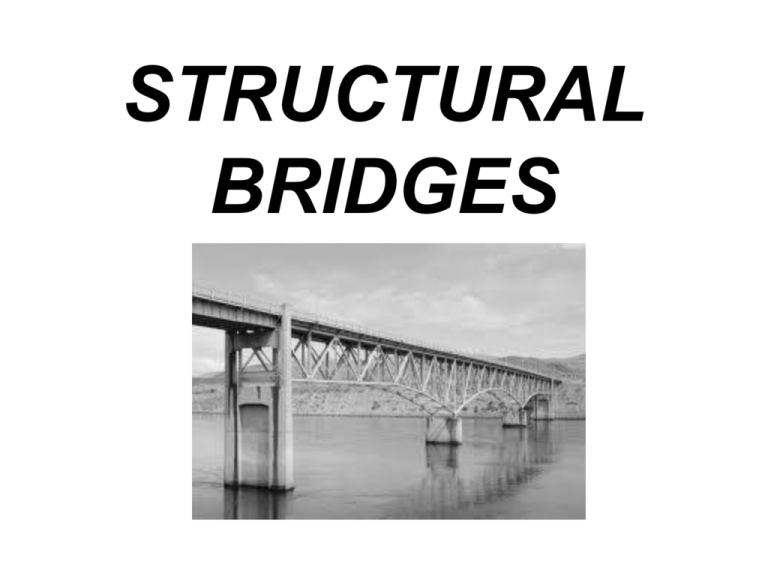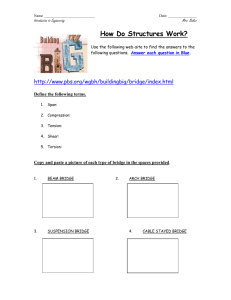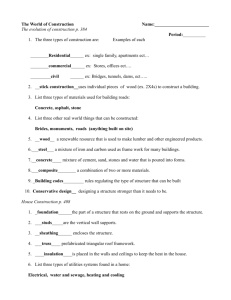Bridge - Foundations of Technology/Systems
advertisement

STRUCTURAL BRIDGES Warm Up Questions 1. What is a bridge? 2. How are bridges used in today’s society? Warm Up Questions 1. Identify the seven types of bridges. 2. Critique the two truss types and explain which truss is stronger. Long Truss Multiple King Post Truss Warm Up Questions 1. Define Bridge. 2. Describe a type of bridge. 3. Explain the type of truss that you have selected for your bridge. What is a Bridge? • A bridge extends a roadway across a land obstacle or over water (excluding oceans). • The design of the bridge depends on the obstacle being crossed and the load the bridge will carry. Types of Bridges • • • • Suspension Arch Beam Truss • Cantilever • Cable-Stayed • Movable/Draw Definitions (Copy) • Live Load – Weight that moves or changes; A variable weight on a structure, such as moving traffic on a bridge. • Dead Load – Weight that does not move; The invariable weight of a structure, such as a bridge. It may also include any permanent loads attached to the structure. Load Exercise: Using the definitions, identify which loads on a bridge are “live” and which are “dead”. • • • • • Trucks parked Concrete road Wind People walking Grocery in the trunk • • • • • Bridge signs Snow Paint lines on the road Street lamps Rain water Bridge Construction Vocabulary Terms Using internet sources, define the following terms AND use them in a sentence that relates to bridges: • Abutment • Anchorages • Arch Bridge • Compression • Cable-stayed bridge • Tension • Cantilever bridge • Buckling • Girder • Snapping • Pier • Dissipate • Span • Transfer • Suspension • Torsion • Truss • Deck-stiffening trusses Compression is the action or state of being squished down or made smaller or more pressed together. Tension is the force created by pulling something tight or a strain. Torsion is the process or condition of twisting or turning one end while the other end is held firm or twisted in the opposite direction. Shear is a force acting in a direction parallel to a surface with and opposite force acting in the other direction. Brief Constructed Response #1 • You are a bridge inspector that has been hired to inspect truss bridges. • Write 4 to 6 sentences that explains how “Live” and “Dead” loads would be handled in your truss design. • Use examples to illustrate how these loads would be supported. Straw Bridge Activity • In groups of two’s, student will construct a prototype of a truss using straws and tape. • Log on to the class website: http://technologysystems.yolasite.com and go to the assignments page; • Open the file: Truss Types (under BridgeBuilding) and select a truss to build using twenty straws. Extended Constructed Response # 1 You are a hired Engineer designed to build a truss bridge for the new town. Your employers are not convinced that your bridge design would be successful. Create a BCR that explains how your truss bridge will withstand the forces placed on bridges: Compression, Tension, Shear, and Torsion. Student Activity #1 Students must identify at least three different truss bridges in Connecticut and bring in a picture of each type of truss bridge. Student Activity #2 VIRTUAL BRIDGE FORCES EXPERIMENT • Access the following website: http://www.pbs.org/wgbh/buildingbig/lab/forces.html • Students must complete the virtual experiments and write a 3 to 4 paragraph summary. – Bridge Location details – Bridge Span to be covered – Type of bridge necessary at that location – Explain how the selected bridge works at that location and why others won’t work. Student Activity #3 • VIRTUAL BRIDGE-BUILDING EXPERIMENT: Students must complete the virtual experiments as well as see real life examples and write a 4 to 6 paragraph summary. • Access the following website to do the virtual bridge-building experiments: http://www.pbs.org/wgbh/buildingbig/bridge/chall enge/index.html Student Activity #4 1. Draw a sketch of your bridge; 2. Identify which popsicle/toothpick sticks are in compression and tension; 3. In 1-2 paragraphs, explain how your bridge supports loads.





